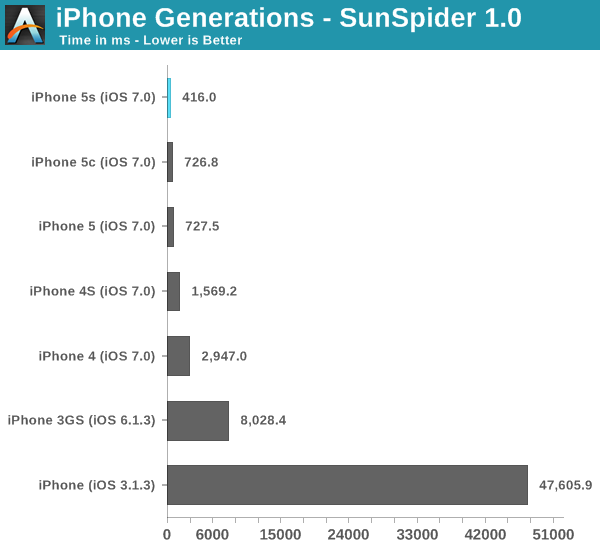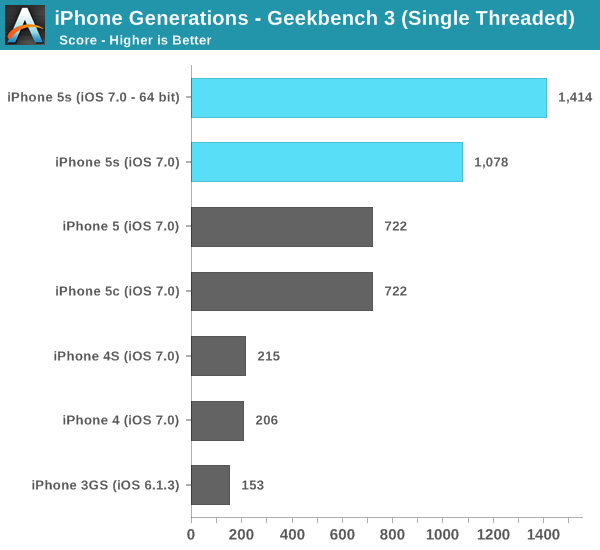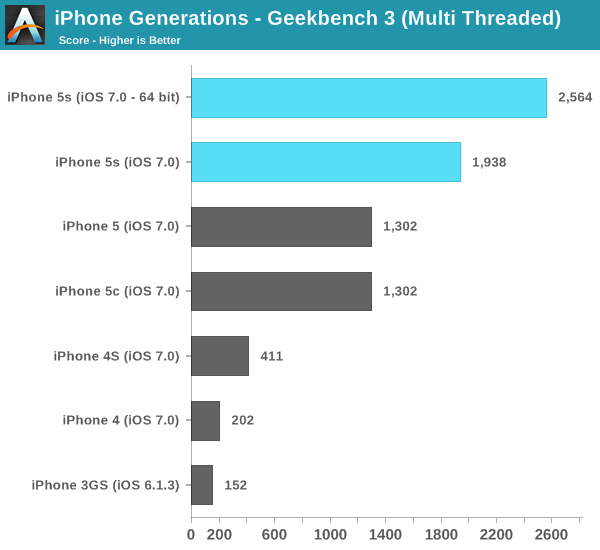The iPhone 5s Review
by Anand Lal Shimpi on September 17, 2013 9:01 PM EST- Posted in
- Smartphones
- Apple
- Mobile
- iPhone
- iPhone 5S
iPhone Performance Across Generations

Performance improved by a factor of 100x compared to the original iPhone. You can cut that in half if the iPhone could run iOS 4. Needless to say, Apple's CPU performance estimates aren't unreasonable. We've come a long way since the days when ARM11 cores were good enough.
Even compared to a relatively modern phone like the iPhone 4, the jump to a 5s is huge. The gap isn't quite at the level of an order of magnitude, but it's quickly approaching it. Using the single core iPhone 4 under iOS 7 just feels incredibly slow. Starting with the 4S things get a lot better, but I'd say the iPhone 4 is at the point now where it's starting to feel too slow even for normal consumers (at least with iOS 7 installed).

Browsermark 2.0 gives us a good indication of less CPU bound performance gains. Here we see over a 5x increase in performance compared to the original iPhone, and an 83% increase compared to the iPhone 4.
I wanted to have a closer look at raw CPU performance so I turned to Geekbench 3. Unfortunately Geekbench 3 won't run on anything older than iOS 6, so the original iPhone bows out of this test.

Single threaded performance scaled by roughly 9x from the 3GS to the iPhone 5s. The improvement since the iPhone 4/4S days is around 6.5x. Single threaded performance often influences snappiness and UI speed/feel, so it's definitely an important vector to scale across.

Take into account multithreaded performance and the increase over the 3GS is even bigger, almost 17x now.
The only 3D test I could get to reliably run across all of the platforms (outside the original iPhone) was Basemark X. Again I had issues getting Basemark X running in offscreen mode on iOS 7 so all of the tests here are run at each device's native resolution. In the case of the 3GS to 4 transition, that means a performance regression as the 3GS had a much lower display resolution to deal with.

Apple has scaled GPU performance pretty much in line with CPU performance over the years. The 5s scores 15x the frame rate of the iPhone 4, at a higher resolution too.
iPhone 5s vs. Bay Trail
I couldn't help but run Intel's current favorite mobile benchmark on the iPhone 5s. WebXPRT by Principled Technologies is a collection of browser based benchmarks that use HTML5 and js to simulate a number of workloads (photo editing, face detection, stocks dashboard and offline notes).

Granted we're comparing across platforms/browsers here, but the 5s as a platform does extremely well in Intel's favorite benchmark. The 5c by comparison performs a lot more like what we'd expect from a smartphone platform. The iPhone 5s is in a league of its own here. While I don't expect performance equalling the Atom Z3770 across the board, the fact that Apple is getting this close (with two fewer cores at that) is a testament to the work done in Cupertino.
At its launch event Apple claimed the A7 offered desktop class CPU performance. If it really is performance competitive with Bay Trail, I think that statement is a fair one to make. We're not talking about Haswell or even Ivy Bridge levels of desktop performance, but rather something close to mobile Core 2 Duo class. I've broken down the subtests in the table below:
| WebXPRT Performance (time in ms, lower is better) | ||||||
| Chrome/Mobile Safari | Photo Effects | Face Detection | Stocks | Offline Notes | ||
| Apple iPhone 5s (Apple A7 1.3GHz) | 878.9 ms | 1831.4 ms | 436.1 ms | 604.6 ms | ||
| Intel Bay Trail FFRD (Atom Z3770 1.46GHz) | 693.5 ms | 1557.0 ms | 542.9 ms | 737.3 ms | ||
| AMD A4-5000 (1.5GHz) | 411.2 ms | 2349.5 ms | 719.1 ms | 880.7 ms | ||
| Apple iPhone 5c (Apple A6 1.3GHz) | 1987.6 ms | 4119.6 ms | 763.6 ms | 1747.6 ms | ||
It's not a clean sweep for the iPhone 5s, but keep in mind that we are comparing to the best AMD and Intel have to offer in this space. I suspect part of why this is close is because both of those companies have been holding back a bit (there's no rush to build the fastest low margin parts), but it doesn't change reality.










464 Comments
View All Comments
cknobman - Wednesday, September 18, 2013 - link
Here is the long/short of this an every other Apple review.Anand (and any other reviewer), whether consciously or sub-consciously, is compelled to write a Apple product review that spins everything in a positive or "not too negative, glass half full" light no matter what the facts really are.
Why? Because if he (they) don't they will be pulled from Apples teet and no longer given their products pre-release (and likely for free) to review.
repoman27 - Wednesday, September 18, 2013 - link
Here is the long and short of this and any other review posted online these days:Whatever is said by the reviewer, the comments section is flooded with posts by whiney haters, obsequious fanboys and a good dose of trolling from both sides.
If you're talking about Anandtech reviews, you are presented with a considerable amount of empirical data combined with a pretty solid technical analysis as well as subjective impressions. If you disagree with the reviewer's conclusions, believe that certain data points are erroneous, or feel that their subjective impressions are biased, why not present your own research, analysis or hands on experiences?
What are the facts? That you don't enjoy seeing positive reviews of Apple products and are therefore suggesting that the only way they could be garnering such praise is due to a breach of journalistic integrity for the sake of getting a couple phones one week before the general public? Face it, the way the review system works (aside from Consumer Reports) is that the OEMs provide review samples in the hopes of getting positive press for cheap, and the reviewers need to cover the latest kit first so they can attract as many eyeballs as possible to their publications in order to generate ad revenue.
Dug - Wednesday, September 18, 2013 - link
repoman27- Couldn't have said it better myself.cknobman- if something is better than wouldn't that be positive? Or should Anand just make snide comments about Apple to make you happy. I don't see how getting 50% more performance would be looked at any other way.
darkcrayon - Wednesday, September 18, 2013 - link
Whiners hate it when the facts present a pro-Apple bias.Streamlined - Thursday, September 19, 2013 - link
Great comment. The design and engineering by Apple is at such a level that anyone who refuses to acknowledge it is a blind hater looking for something to gripe about.drtaxsacto - Wednesday, September 18, 2013 - link
Thanks very much for such a thorough review. The detailed benchmarks and other comments were well done.mattyroze - Wednesday, September 18, 2013 - link
The first page is all about the color and case. Shouldn't that be the last page? If at all? This tells me the iPhone 5S is nothing more than a status update in the world of device computing. Thanksscottwilkins - Wednesday, September 18, 2013 - link
I would have REALLY liked to have seen a Nokia put in the mix of these test. Especially with camera and display, if not power and all others too.Abelard - Wednesday, September 18, 2013 - link
Thanks for the review. The A7 and M7 combo sound intriguing. Can't wait for the Chipworks folks to take a closer look and post some pics. I wonder what (if anything) Apple has in mind for the M7...ianmolynz - Wednesday, September 18, 2013 - link
An interesting review but largely academic [Ferrari versus Porsche] Most people use their devices to communicate so the real performance bottleneck is always going to be the external cellular and data services they connect to. All the devices listed have good to great graphical performance so unless an app or mobile site is poorly architectured you won't get much in the way of on-device latency. We as consumers are spoilt for choice so it really comes down to personal preference.